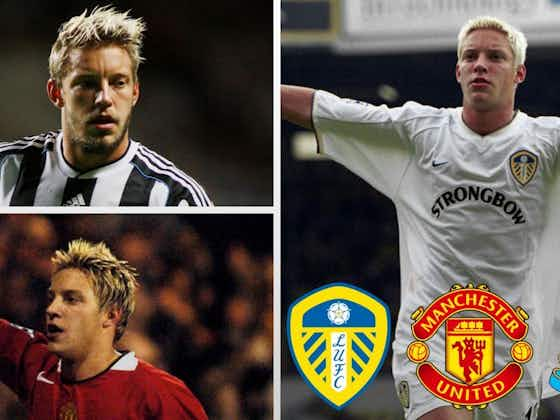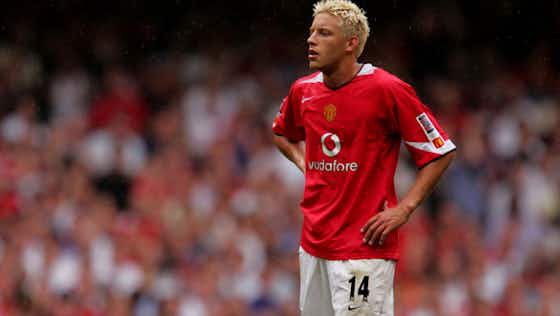Football League World
·27. April 2024
Despite controversy Leeds United got more out of livewire than Man United and Newcastle managed: View

Football League World
·27. April 2024

Alan Smith's time as a Leeds United player will be remembered by those on the Elland Road terraces for a mixture of reasons.
The striker came through the academy at Elland Road, making his debut for the club at the age of 18 against Liverpool and scoring with his first touch in senior football.
Smith was a crown jewel in an exciting Leeds side. As a local lad, he was a dyed in the wool Whites fan, and some considered him to be the very embodiment of the club.
The fans absolutely adored Smith, and were thrilled by his performances after coming through as a youngster at Leeds during some real highs. Even his contributions in the 2003/04 campaign that led to the Premier League relegation, he was relatable and passionate, which the fans loved.
making their feelings clear in a pre-season friendly in 2009.
Smith's time at Leeds was the most productive of the Englishman's career. He spent six seasons with his hometown club, experiencing all the highs and lows of Premier League and Champions League football.
He was a key player, playing both up front and on the right, as Leeds had some of their most successful years in the Premier League. He led the line as Leeds finished in the top four between 1999 and 2001. This included an incredible run to the Champions League semi-final in 2001, where the club had one of their best runs in Europe in the club's history.
Smith was part of a star-studded squad, which included Rio Ferdinand, Mark Viduka and Jonathan Woodgate amongst its hoards of talent. However, the England striker was something of a jewel in the crown, and was voted as the Players' Player of the Year in two consecutive years: 2003 and 2004.
While he was touted as a star for Leeds, Smith never had the best goal scoring record. His best season saw him score only 11 Premier League goals, with only 12 assists throughout six seasons at the club.
However, it was his all-around game that endeared fans to him. He could finish, would run a lot, was good with both feet and wasn't afraid to get stuck in. With that and being a local lad, he was exactly the kind of player that fans loved.
His disciplinary record showed his passion for the club, getting stuck in at every opportunity. Smith picked up 53 yellow and seven red cards for the Whites, which was another reason why he was so beloved by fans at Elland Road, despite the obvious frustrations that came with that; he played for the badge, which is all most football fans want.
Smith scored 54 times in 224 matches for the Whites, before leaving to join their biggest rivals Man United after relegation in 2004.

Smith moved to Manchester United in 2004 after Leeds were relegated to the Championship. Moving to the club's fiercest rivals naturally put him in the bad books with the Leeds' faithful, although the £7 million they received helped the Whites stay in business after years of overspending - a wider picture to consider amongst the fury.
This caused huge controversy at the time. Man United and Leeds were fierce rivals, and Smith had previously claimed that he would never join the Red Devils. While it seemed like an impossible move, the massive debt Leeds were under after facing relegation meant selling one of their prized assets became a necessity.
United were the only Champions League side who had a bid accepted for Smith, so he had very little choice about who to join after leaving Leeds that summer in a bid to further his career, which had seen him reach the top of the game whilst at Elland Road.
However, Sir Alex Ferguson did not sign him to play up front. With the likes of Louis Saha, Ruud Van Nistlerooy and Wayne Rooney starring at Old Trafford during Smith's time at the club, the Scot saw him regressing into a midfield role.
Ferguson did the same with Paul Scholes years earlier, with the Englishman turning from a striker into one of the top midfielders in the country. Smith was being groomed to replace Roy Keane in the United midfield, something the former Leeds man was happy with after the move.
"The gaffer has said he's no longer experimenting with me in that position. That's where he wants me to play. I'm happy with that and as the season develops I will get better," Smith said to Sky Sports.
Sadly, an injury stopped his development as a midfielder in 2006, when Smith had his leg broken blocking a free-kick from John Arne Riise in a match against Liverpool. Soon after returning from injury, he was sold to Newcastle.
He never hit the heights he did at Leeds at either of those clubs. Smith scored just 12 times for the Red Devils from his midfield role and wasn't the much-loved character he had been at Elland Road, although his trophy count probably outweighed some of that. He only played 93 matches in all competitions for the club, due to injuries.
He also scored just four times for Newcastle, although he was mostly used in midfield again during his time at St James' Park. He did find success at St James' Park, being a part of their promotion winning side in the Championship in 2010, whilst also carrying the captain's armband on occasion.
While Smith won trophies with the Red Devils and a promotion with Newcastle, his real success came at Leeds. Reaching the latter stages of the Champions League with his hometown club, as one of the stars of the team and a key source of goals, is a much bigger achievement than what he managed in his later career. It was also at Elland Road when he first received international recognition for England.
He had much less to do with the successes of his Old Trafford days, and his Championship winning season with Newcastle, with him moved back into midfield, had him less front-and-centre. Injuries almost ruined his career, and he never had a period of full-fitness while playing up front as he did during his time at Leeds, where he could totally use his aggression and willing running to cause defenders no end of problems.
His goalscoring peak also came at Leeds as a result of that, and he was part of the club's most successful side since 1992.
Smith wasn't without controversy at Leeds owing to his red cards, and he certainly wasn't well received after moving to Man United, but there's little denying looking back on his career now, where he was most appreciated and, ultimately, played his best football.






























































